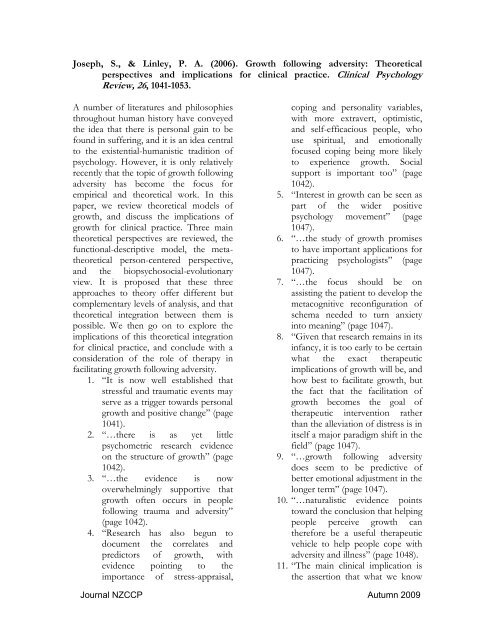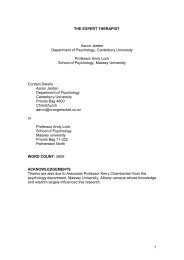Posttraumatic growth: an introduction and review. - Aaron Jarden
Posttraumatic growth: an introduction and review. - Aaron Jarden
Posttraumatic growth: an introduction and review. - Aaron Jarden
You also want an ePaper? Increase the reach of your titles
YUMPU automatically turns print PDFs into web optimized ePapers that Google loves.
Joseph, S., & Linley, P. A. (2006). Growth following adversity: Theoretical<br />
perspectives <strong>an</strong>d implications for clinical practice. Clinical Psychology<br />
Review, 26, 1041-1053.<br />
A number of literatures <strong>an</strong>d philosophies<br />
throughout hum<strong>an</strong> history have conveyed<br />
the idea that there is personal gain to be<br />
found in suffering, <strong>an</strong>d it is <strong>an</strong> idea central<br />
to the existential-hum<strong>an</strong>istic tradition of<br />
psychology. However, it is only relatively<br />
recently that the topic of <strong>growth</strong> following<br />
adversity has become the focus for<br />
empirical <strong>an</strong>d theoretical work. In this<br />
paper, we <strong>review</strong> theoretical models of<br />
<strong>growth</strong>, <strong>an</strong>d discuss the implications of<br />
<strong>growth</strong> for clinical practice. Three main<br />
theoretical perspectives are <strong>review</strong>ed, the<br />
functional-descriptive model, the metatheoretical<br />
person-centered perspective,<br />
<strong>an</strong>d the biopsychosocial-evolutionary<br />
view. It is proposed that these three<br />
approaches to theory offer different but<br />
complementary levels of <strong>an</strong>alysis, <strong>an</strong>d that<br />
theoretical integration between them is<br />
possible. We then go on to explore the<br />
implications of this theoretical integration<br />
for clinical practice, <strong>an</strong>d conclude with a<br />
consideration of the role of therapy in<br />
facilitating <strong>growth</strong> following adversity.<br />
1. “It is now well established that<br />
stressful <strong>an</strong>d traumatic events may<br />
serve as a trigger towards personal<br />
<strong>growth</strong> <strong>an</strong>d positive ch<strong>an</strong>ge” (page<br />
1041).<br />
2. “…there is as yet little<br />
psychometric research evidence<br />
on the structure of <strong>growth</strong>” (page<br />
1042).<br />
3. “…the evidence is now<br />
overwhelmingly supportive that<br />
<strong>growth</strong> often occurs in people<br />
following trauma <strong>an</strong>d adversity”<br />
(page 1042).<br />
4. “Research has also begun to<br />
document the correlates <strong>an</strong>d<br />
predictors of <strong>growth</strong>, with<br />
evidence pointing to the<br />
import<strong>an</strong>ce of stress-appraisal,<br />
coping <strong>an</strong>d personality variables,<br />
with more extravert, optimistic,<br />
<strong>an</strong>d self-efficacious people, who<br />
use spiritual, <strong>an</strong>d emotionally<br />
focused coping being more likely<br />
to experience <strong>growth</strong>. Social<br />
support is import<strong>an</strong>t too” (page<br />
1042).<br />
5. “Interest in <strong>growth</strong> c<strong>an</strong> be seen as<br />
part of the wider positive<br />
psychology movement” (page<br />
1047).<br />
6. “…the study of <strong>growth</strong> promises<br />
to have import<strong>an</strong>t applications for<br />
practicing psychologists” (page<br />
1047).<br />
7. “…the focus should be on<br />
assisting the patient to develop the<br />
metacognitive reconfiguration of<br />
schema needed to turn <strong>an</strong>xiety<br />
into me<strong>an</strong>ing” (page 1047).<br />
8. “Given that research remains in its<br />
inf<strong>an</strong>cy, it is too early to be certain<br />
what the exact therapeutic<br />
implications of <strong>growth</strong> will be, <strong>an</strong>d<br />
how best to facilitate <strong>growth</strong>, but<br />
the fact that the facilitation of<br />
<strong>growth</strong> becomes the goal of<br />
therapeutic intervention rather<br />
th<strong>an</strong> the alleviation of distress is in<br />
itself a major paradigm shift in the<br />
field” (page 1047).<br />
9. “…<strong>growth</strong> following adversity<br />
does seem to be predictive of<br />
better emotional adjustment in the<br />
longer term” (page 1047).<br />
10. “…naturalistic evidence points<br />
toward the conclusion that helping<br />
people perceive <strong>growth</strong> c<strong>an</strong><br />
therefore be a useful therapeutic<br />
vehicle to help people cope with<br />
adversity <strong>an</strong>d illness” (page 1048).<br />
11. “The main clinical implication is<br />
the assertion that what we know<br />
Journal NZCCP Autumn 2009





